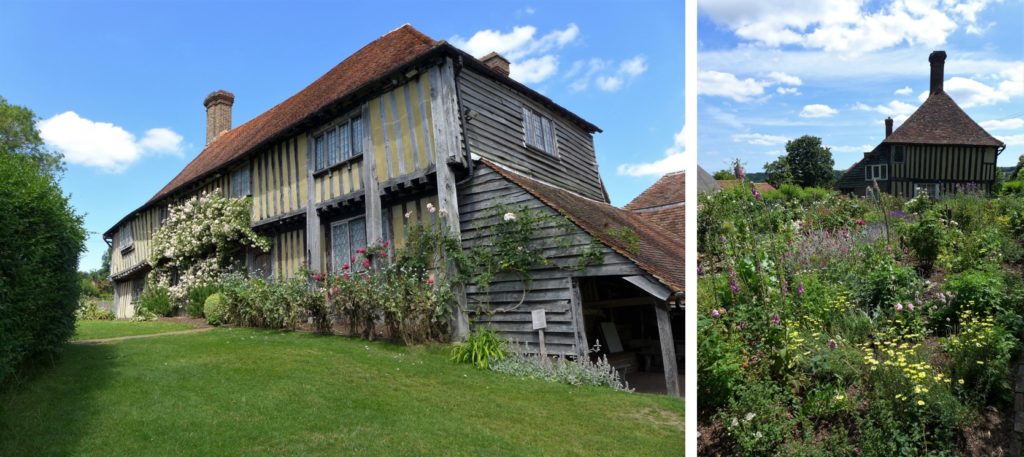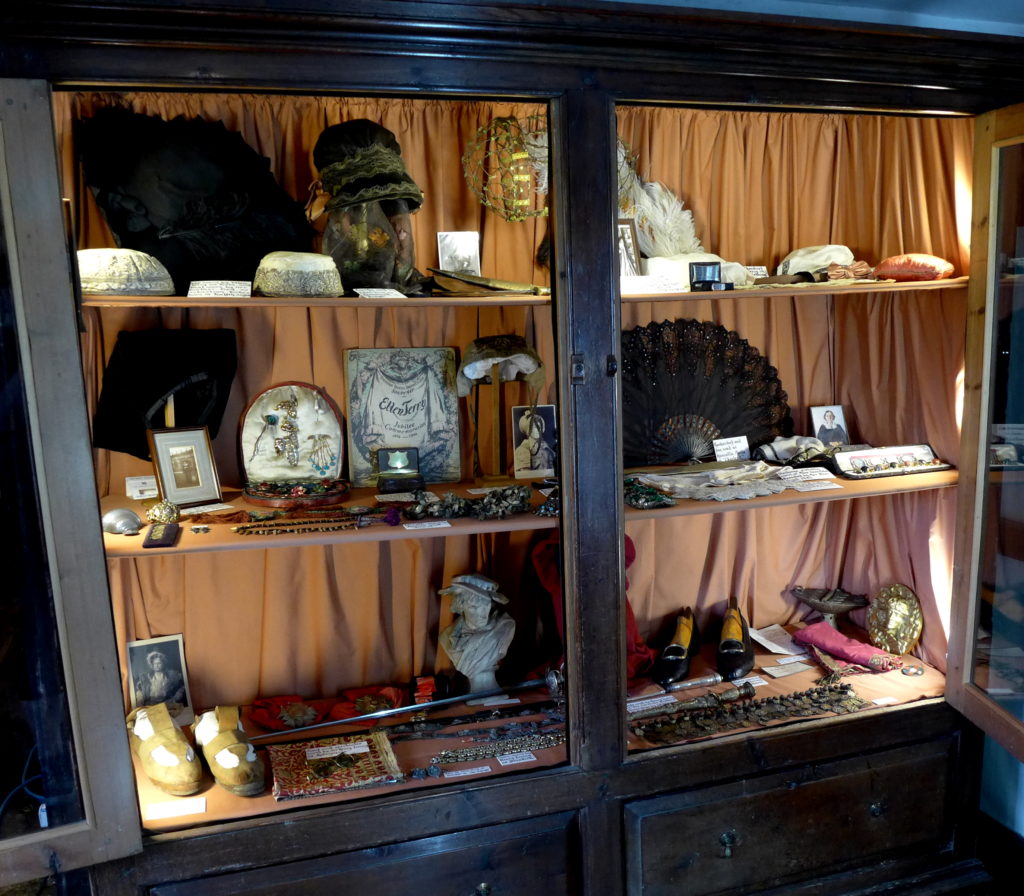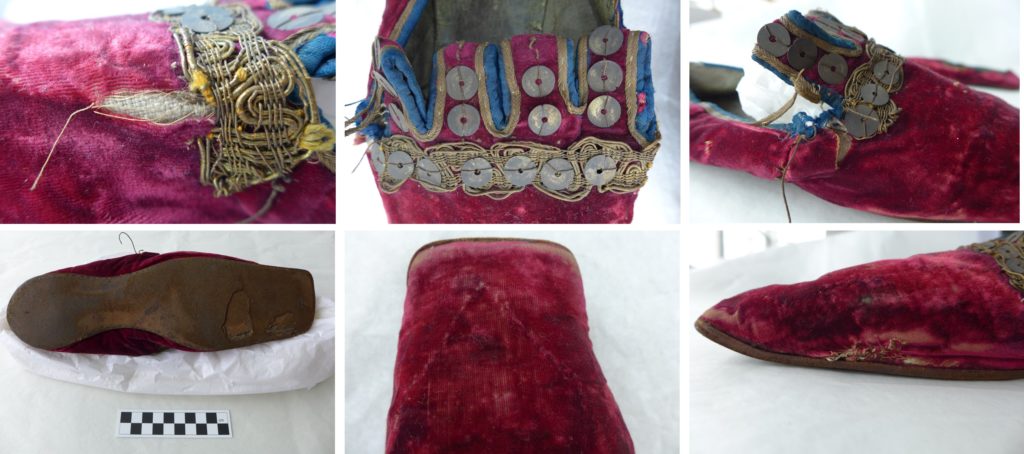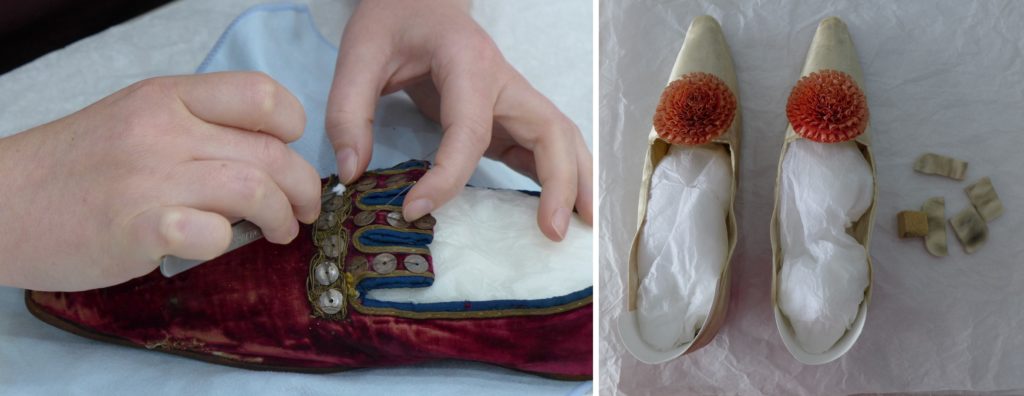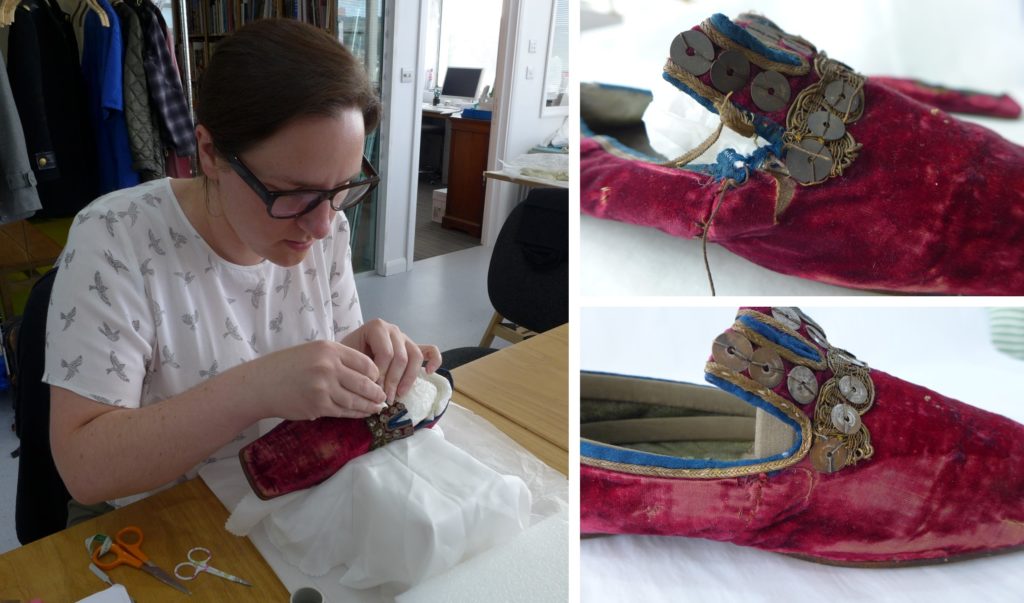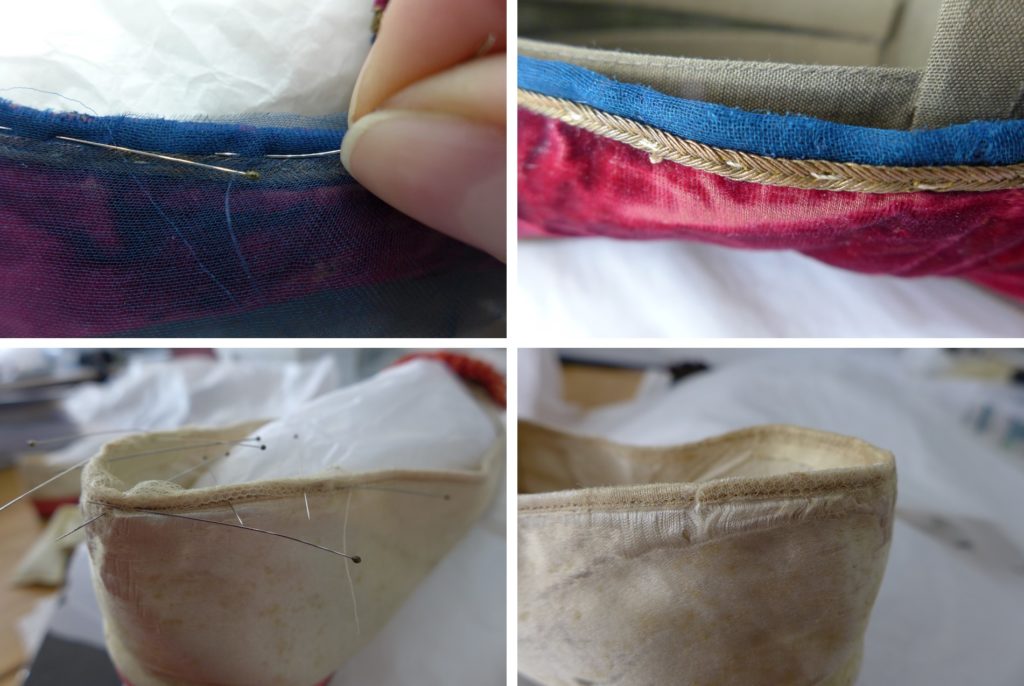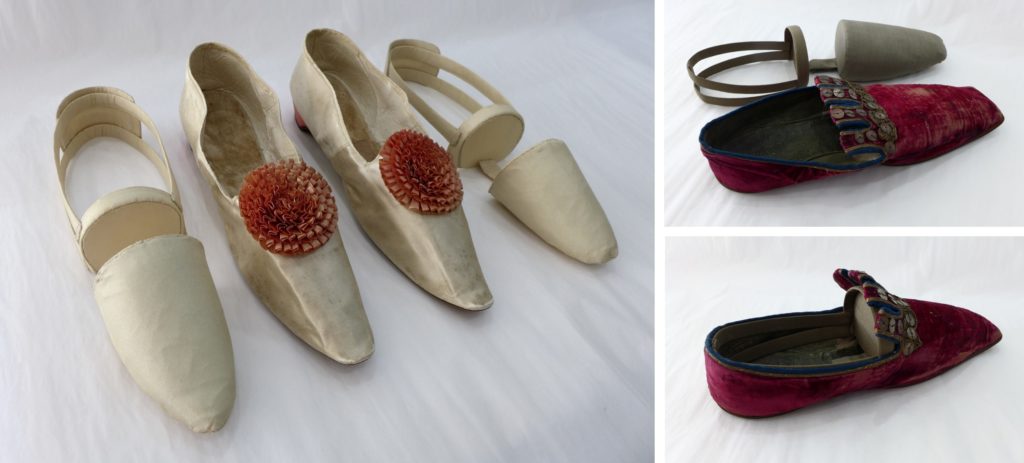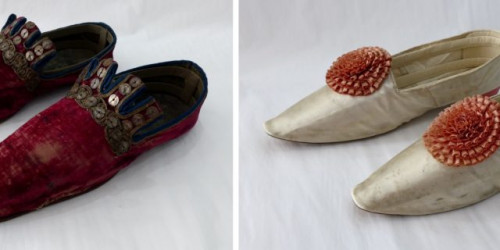
By Caterina Celada Prior, Intern at ZTC Summer 2019. This summer I moved from the Scottish Glasgow rain to the sunny Brighton to spend an excellent time as intern at Zenzie Tinker Conservation studio, following the first year of the MPhil in Textile Conservation from the University of Glasgow. I have enjoyed my time working on a variety of projects – in the studio and on site – surrounded by and learning from a skilful and welcoming team of conservators. I have not only developed my skills but also I have gained insight about the particularities and challenges of private practice. Amongst the different projects I worked on, two pairs of theatrical shoes belonging to the Ellen Terry’s Collection (Smallhythe, National Trust Property) become my main project. These were small but challenging objects, a treat for a lover of a bit of a fiddle! (like me).
Although I had the opportunity to work on shoes before, this was a complete new challenge. Some objects may share similarities on a first glance, but there are as many conservation issues as pairs of shoes. We could say that stepping into else’s shoes takes on a particular meaning in this case – textile conservation – where every object, every pair of shoes, carries a particular identity, story, life and therefore, conservation issues and challenges, becoming one of the joys of this profession.
Dame Ellen Terry was an esteemed Victorian actress (1847-1928) who dominated the theatrical scene during the late 19th and early 20th centuries, becoming and international celebrity. [1] She left a magnificent collection of personal and professional artefacts bringing insight and revealing secrets from the theatrical world of her era. This is held at Smallhythe Place (a small fairy tale cottage in Kent), her retirement house which has become a lovely memorial museum – worth visiting! In the Lyceum Room, showcases display a collection of mementoes from Ellen’s performances. [2] Amongst them, we can find the two pairs of shoes, main characters in this occasion.
The first pair of shoes, red velvet pumps (c. 1837 ?) worn by Samuel Phelps (1804 -1878) as ‘Shylock’ in Shakespeare’s ‘Merchant of Venice’ (http://www.nationaltrustcollections.org.uk/object/1118760 ), represents one of many celebrities from the era sharing the stage with Ellen Terry, while the second, a pair of white slippers (c.1850-60 ?) with beautiful rosettes (http://www.nationaltrustcollections.org.uk/object/1118755), would have been worn by the actress herself.
Dating theatrical garments is a difficult task due that often intend to represent different historical eras. In this case, missing manufacturer’s labels – or information on them- arouse my curiosity. Through a bit of research I could find examples of similar style and embellishments in the collection of the Victoria & Albert Museum Collection that can be seen here (T.525-1913 http://collections.vam.ac.uk/item/O356367/pair-of-shoes/ , T.562&A-1913 http://collections.vam.ac.uk/item/O134892/pair-of-shoes-latham/ and T.212&A-1915 http://collections.vam.ac.uk/item/O170938/pair-of-shoes-carltone-richard/ ). These examples together with a reference of Samuel Phelps first London (Haymarket Theatre) appearance in ‘The Merchant of Venice’ in August 28, 1837, [3] helped me to understand a bit more of the history of these pieces. Both, looking a bit sad and tired due to unforgiving passing of time and a well-loved long life, were patiently waiting to bright again.
Reading the numerous wear and tear signs with soling, unstitched and broken seams, splits and areas of loss, missing spangles, folds, general distortion, old repairs and signs of lost decorations, I can only imagine the hard work of actors and the many performances and stages these shoes have stepped on. In addition, the little pains of age such as the powdery velvet pile (lost in many areas and hampering handling) and the faded dye colouration and silk brittleness caused by damaging action of light, did not help either, contributing to a fragile and disfiguring condition.
I was not able to address the damages more related to ageing than use. However, I was able to return – to a greater extent – the mechanical and aesthetical cohesion to the shoes through an extensive interventive treatment, more extensive on the red velvet pumps with poorer condition – and more complex construction, requiring intensive care. The conservation process, due to the three dimensional nature of the shoes and their small size, became a fiddling job – stage after stage, a good challenge to train patience and manual skills.
Cleaning the soling – surface and ingrained – acquired during working life and retirement – as museum objects – became the first challenge due to the fragile – and unforgiving- state of both external fabrics (velvet pile and white silk). With very gentle use of makeup sponges and fiddling with small pieces of conservation grade eraser I managed to partially remove the most disfiguring traces of soiling and bring back some sheen to the metal decorations, respectively.
While the white slippers required the stabilisation and reinforcement of the heels’ edges – mainly on the external silk – , the red pumps – overall the proper right shoe – was severely structurally damaged, both internally and externally. In these, I had to first stabilise the main internal seams by using the original holes left by the broken thread (not an easy task, that makes you discover how big your hands are! ), to then work on the external velvet layers with splits and areas of loss. In both pairs, I inserted small silk patches in matching colours between the external fabric and the lining, providing support for stitching and a visual infill. I laid-couched them in place with very fine threads pulled from polyester crepeline (Stabiltex™ / Tetex™).
In case I was not yet aware of the size of my fingers, the overlay process of the damaged blue edging on the throat of the velvet shoe and the cream edging on the heel of the white slipper, made sure of it. I applied an overlay of blue dyed silk crepeline and a cream netting, respectively, which after a bit of struggle and great fun, worked well for both, an unexpected personal satisfaction and a good improvement of the condition of the shoes.
Finally, I worked on the last touches – that took me a surprisingly long time – on the decorative pieces attached to the shoes, such as reinforcing all the thread securing the metal spangles, reshaping the metal thread braid or reattaching the pink rosette, before starting with one of the main part of these treatments, the internal mount for display and storage.
Mounts for display are not only a random volume filling in the internal space of a shoe – or a garment – but a method of providing the structural support that the object may have lost, helping on a good reading of the object as this is the case. Last but not least, I had to create a bespoke internal mount that provided enough support to counteract the misshapen action of folds (unresponsive to humidification), enabling at the same time the visual access to the interior of the shoes. I created a two-piece mounts – formed by a frontal padded cushion and a posterior scaffolding-like structure in Rigelene™ – covered in silk matching the interior of each shoe. This was a real challenge for me, not only for my manual skills but on testing my patience – as the Cinderella’s prince – trying to find the right fitting for each shoe.
I am glad to see now the shoes happily back to scene, presenting a recovered splendour a bit closer to which they had when originally worn on stage. I was delighted to have the opportunity to work on these beautiful pieces from such remarkable collection. It has been a privilege having a piece of the Scene History in my hands, and contributing to preserve them for the future and so … the show must go on!
[1] Encyclopaedia Britannica. Samuel Phelps, British Actor and Manager. Encyclopaedia Britannica, 2019. (Accessed June 16, 2019.) https://www.britannica.com/biography/Samuel-Phelps
[2] https://www.nationaltrust.org.uk/smallhythe-place/features/the-museum-at-smallhythe-place
[3] https://www.nationaltrust.org.uk/smallhythe-place/features/the-museum-at-smallhythe-place



